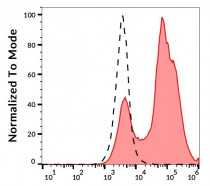ARG42457
anti-CD26 / DPP4 antibody [H194-112]
anti-CD26 / DPP4 antibody [H194-112] for Flow cytometry,IHC-Frozen sections,Immunoprecipitation and Mouse
Overview
| Product Description | Rat Monoclonal antibody [H194-112] recognizes CD26 / DPP4 |
|---|---|
| Tested Reactivity | Ms |
| Tested Application | FACS, IHC-Fr, IP |
| Specificity | The rat monoclonal antibody H194-112 recognizes an extracellular epitope of CD26, a 110 kDa type II membrane glycoprotein, which is a peptidase expressed on mature thymocytes, T cells (especially activated), B cells, NK cells and macrophages. |
| Host | Rat |
| Clonality | Monoclonal |
| Clone | H194-112 |
| Isotype | IgG2a, kappa |
| Target Name | CD26 / DPP4 |
| Antigen Species | Mouse |
| Immunogen | BALB/c thymocytes. |
| Conjugation | Un-conjugated |
| Alternate Names | T-cell activation antigen CD26; ADCP2; ADCP-2; DPP IV; Adenosine deaminase complexing protein 2; CD26; EC 3.4.14.5; ADABP; Dipeptidyl peptidase IV soluble form; Dipeptidyl peptidase IV; Dipeptidyl peptidase 4; Dipeptidyl peptidase IV membrane form; TP103; DPPIV; CD antigen CD26 |
Application Instructions
| Application Suggestion |
|
||||||||
|---|---|---|---|---|---|---|---|---|---|
| Application Note | * The dilutions indicate recommended starting dilutions and the optimal dilutions or concentrations should be determined by the scientist. |
Properties
| Form | Liquid |
|---|---|
| Purification | Purification with Protein A. |
| Buffer | PBS and 15 mM Sodium azide. |
| Preservative | 15 mM Sodium azide |
| Concentration | 1 mg/ml |
| Storage Instruction | For continuous use, store undiluted antibody at 2-8°C for up to a week. For long-term storage, aliquot and store at -20°C or below. Storage in frost free freezers is not recommended. Avoid repeated freeze/thaw cycles. Suggest spin the vial prior to opening. The antibody solution should be gently mixed before use. |
| Note | For laboratory research only, not for drug, diagnostic or other use. |
Bioinformation
| Database Links | |
|---|---|
| Gene Symbol | DPP4 |
| Gene Full Name | dipeptidyl-peptidase 4 |
| Background | The protein encoded by this gene is identical to adenosine deaminase complexing protein-2, and to the T-cell activation antigen CD26. It is an intrinsic membrane glycoprotein and a serine exopeptidase that cleaves X-proline dipeptides from the N-terminus of polypeptides. [provided by RefSeq, Jul 2008] |
| Function | Cell surface glycoprotein receptor involved in the costimulatory signal essential for T-cell receptor (TCR)-mediated T-cell activation. Acts as a positive regulator of T-cell coactivation, by binding at least ADA, CAV1, IGF2R, and PTPRC. Its binding to CAV1 and CARD11 induces T-cell proliferation and NF-kappa-B activation in a T-cell receptor/CD3-dependent manner. Its interaction with ADA also regulates lymphocyte-epithelial cell adhesion. In association with FAP is involved in the pericellular proteolysis of the extracellular matrix (ECM), the migration and invasion of endothelial cells into the ECM. May be involved in the promotion of lymphatic endothelial cells adhesion, migration and tube formation. When overexpressed, enhanced cell proliferation, a process inhibited by GPC3. Acts also as a serine exopeptidase with a dipeptidyl peptidase activity that regulates various physiological processes by cleaving peptides in the circulation, including many chemokines, mitogenic growth factors, neuropeptides and peptide hormones. Removes N-terminal dipeptides sequentially from polypeptides having unsubstituted N-termini provided that the penultimate residue is proline. [UniProt] |
| Cellular Localization | Dipeptidyl peptidase 4 soluble form: Secreted. Cell membrane. Apical cell membrane. Cell projection, invadopodium membrane. Cell projection, lamellipodium membrane. Cell junction. Membrane raft. [UniProt] |
| Calculated MW | 88 kDa |
| PTM | The soluble form (Dipeptidyl peptidase 4 soluble form also named SDPP) derives from the membrane form (Dipeptidyl peptidase 4 membrane form also named MDPP) by proteolytic processing. N- and O-Glycosylated. Phosphorylated. Mannose 6-phosphate residues in the carbohydrate moiety are necessary for interaction with IGF2R in activated T-cells. Mannose 6-phosphorylation is induced during T-cell activation. [UniProt] |
Images (1) Click the Picture to Zoom In
-
ARG42457 anti-CD26 / DPP4 antibody [H194-112] FACS image
Flow Cytometry: Separation of stained murine splenocytes (red-filled) from unstained murine splenocytes (black-dashed). Cells were stained with ARG42457 anti-CD26 / DPP4 antibody [H194-112] at 4 µg/ml dilution, followed by APC-conjugated Donkey anti-Rat antibody.






